Orthodontic emergencies happen. Instead of worrying about their possibility, use this guide so you’re prepared and calm when they happen. When you handle orthodontic issues properly, you’ll keep happy patients and a highly productive department.
POS Instructor, Dr. Sam Channo, created this detailed guide to help you and your orthodontic team. The following eight orthodontic emergencies and their treatments are listed in order of the least severe to the most severe. Luckily, your staff (and sometimes the patient) can be trained to manage these situations efficiently. Only the most severe emergencies may require immediate attention by the dentist.
How you (and your staff) should manage the most common after hours emergencies
Food Caught Between Teeth
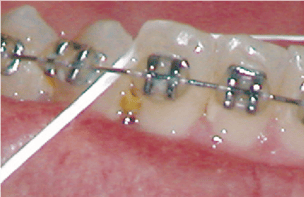
This is not an emergency, but can be a little uncomfortable or embarrassing for the patient wearing braces (and food). It is easily fixed with a piece of dental floss. Try tying a small knot in the middle of the floss to help remove the food or use an interproximal brush or toothpick to dislodge food caught between teeth and braces.
Ligatures Come Off
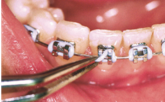
Tiny rubber bands or small, fine wires, known as ligatures, hold the wire to the bracket. Sometimes ligatures come off or become loose with time or eating certain foods.
If a rubber ligature comes off, you may be able to put it back in place using sterile tweezers. If a wire ligature comes loose, your assistant (or even the patient) can simply remove it with sterile tweezers. If the wire ligature is sticking out into the lip but is not loose, it may be bent back down with a Q-tip or pencil eraser to eliminate the irritation.
TIP: When one ligature pops off or breaks, others may follow. Be sure to examine all ligatures. Missing or broken ligatures should be brought to the attention of the patient’s parent or guardian and the dentist or orthodontist. If a rubber or wire ligature is lost, the patient should notify the dentist so he or she may advise whether the patient should be seen immediately or can wait until the next appointment.
Patient Discomfort
It’s normal for a patient to have discomfort for a day or two after braces or retainers are adjusted. But it can make eating uncomfortable. Reassure the patient that the discomfort is both normal and temporary. Encourage soft foods. Have the patient rinse the mouth with warm salt water.
Mouth Sores

Some patients are susceptible to episodes of mouth sores. While braces do not cause them, they may be precipitated or exacerbated by an irritation from braces. One or several areas of ulceration of the cheeks, lips or tongue may appear. This is not an emergency but may be very uncomfortable for the patient.
Prompt relief may be achieved by applying a small amount of topical anesthetic (such as Orabase or Ora-Gel) directly to the ulcerated surface using a cotton swab. Instruct the patient to reapply as needed.
Irritation of Lips or Cheeks
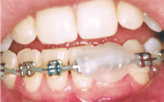
Sometimes new braces can be irritating to the mouth, especially when the patient is eating. A small amount of non-medicinal relief wax makes an excellent buffer between metal and mouth. Simply pinch off a small piece and roll it into a ball the size of a small pea. Flatten the ball and place it completely over the area of the braces causing irritation.
The patient may then eat more comfortably. Let the patient know that if the wax is accidentally ingested, it’s not a problem. The wax is harmless.
Protruding Wire
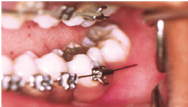
Occasionally, the end of a wire will work itself out of place and irritate the patient’s mouth. Use a Q-tip or pencil eraser to push the wire so that it is flat against the tooth. If the wire cannot be moved into a comfortable position, cover it with relief wax. The patient will need to make the dentist aware of the problem so the dentist or assistant can clip the wire.
In a situation where the wire is extremely bothersome, and the patient will not be able to see the dentist anytime soon, they may, as a last resort, clip the wire. Reduce the possibility of the patient swallowing the snipped piece of wire by using folded tissue or gauze around the area. Use a pair of sharp clippers and snip off the protruding wire. Relief wax may still be necessary to provide comfort to the irritated area.
Loose Brackets, Wires or Bands
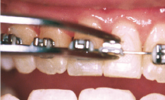
If the braces have come loose in any way, the patient should immediately call the dentist to determine appropriate next steps.
The bracket can be knocked off if the patient has eaten one of those hard or crunchy foods orthodontic patients are instructed to avoid, or if the mouth is struck while at play. (Encourage all patients, especially those with braces, to wear a protective mouth guard while playing sports.) If the bracket is off center, the adhesive may have failed.
If the loose bracket has rotated on the wire and is sticking out and the patient cannot immediately be taken to the orthodontist, the patient can do a temporary fix to alleviate discomfort and prevent further damage.
To put the bracket back in place, use sterile tweezers to slide the bracket along the wire until it is between two teeth. Rotate the bracket back to the proper position, then slide it back to the center of the tooth. Take care to prevent swallowing or other injury.
Piece of Appliance is Swallowed
This is rare, but when it does happen, it can be fairly alarming to the patient. Encourage your patient to remain calm. If the patient is coughing excessively or having difficulty breathing, the piece could have been aspirated.
If you are able to see the piece, you may carefully attempt to remove it. But do not make the attempt if you could cause harm.
If appropriate under the circumstances, examine the patient’s braces for problems that may result from the missing piece, such as looseness or irritation, and treat as specified above.
If you are unable to see the piece and believe it may be have been aspirated, notify the dentist immediately.
____
When your staff knows how to manage orthodontic patients in all situations, your orthodontic department will run smoothly. Read the 50 orthodontic responsibilities your assistants should be doing.
We hope that this quick guide will help you and your assistants make orthodontics hassle-free, even when things happen.
Have you dealt with orthodontic emergencies? Please add questions or comments below:

